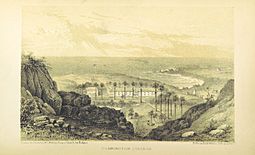Codrington Plantations facts for kids
Quick facts for kids Codrington Plantations |
|
|---|---|

Codrington College, Barbados
|
|
| Location | Barbados |
| Area | 763 acres (309 ha) |
| Established | 17th century |
The Codrington Plantations were two large sugarcane farms on the island of Barbados. They were started in the 1600s by a father and son, both named Christopher Codrington. Like many farms at that time in the Caribbean, they used enslaved people to do the work.
These plantations became very important in 1710. The younger Christopher Codrington (who died in 1710) left them in his will to a group called the Society for the Propagation of the Gospel in Foreign Parts (SPG). This gift was meant to help fund Christian missionary work.
The story of these plantations shows how the Church of England in the 1700s relied on money from rich landowners in the West Indies. It also shows how the Church was slow to address the issue of slavery until the movement to end slavery, called Abolitionism, grew stronger.
Contents
Where Were the Plantations?
The two farms were called Codrington's and Consett's. They were located in the area of St. John on the eastern side of Barbados. Together, they covered about 763 acres (309 hectares) where sugarcane was grown.
In his will, Christopher Codrington mentioned that the land had three windmills for making sugar. He also noted there were 315 enslaved people and 100 cattle on the plantations.
Codrington's Gift and Codrington College
When Christopher Codrington passed away in 1710, he left his two plantations to the Society for the Propagation of the Gospel (SPG). His goal was to use the money from the plantations to build a college in Barbados. He wanted the plantations to stay together and to always have at least 300 enslaved people working there. He also wanted a good number of teachers and students to be supported.
Codrington also wanted some of his gift to be used to educate the enslaved people in Barbados. However, other plantation owners stopped this idea from happening.
The college was built over many years, from 1714 to 1742. Today, the buildings are used as a seminary, which is a school for training religious leaders. It is part of the Church in the Province of the West Indies, which is a branch of the worldwide Anglican Communion.
Christopher Codrington also gave a lot of money and books to All Souls College, Oxford in England. His gifts helped build the Codrington Library there.
Life on the Plantations
Managers ran the plantations for the SPG. A group of trustees, led by the Archbishop of Canterbury and other Church of England bishops, were supposed to oversee how the plantations were run.
The plantations needed a constant supply of new enslaved people from West Africa. Life was very hard for them. Many suffered from illness, like smallpox and dysentery, and from mistreatment. Records from 1740 show that four out of every ten enslaved people bought by the plantation died within three years.
At first, some enslaved people were marked with the word "Society" on their chests using a hot iron. This was a harsh practice. However, this branding policy stopped within ten years of the Church taking ownership of the plantation. The main ways to control people were through harsh punishments, like whipping.
Historians note that conditions were very difficult for enslaved people across the Caribbean. Many died during the difficult journey from Africa, known as the middle passage. They also struggled to adjust to new foods, diseases, and hard labor. At Codrington, new enslaved people from Africa were "seasoned" for three years. This meant they received extra food and lighter work. If they survived these three years, they were considered ready for the hardest labor.
By 1826, the Church of England's Codrington plantation had made some improvements. They provided better food, housing, clothing, and working conditions. They also built a small hospital for enslaved people who were sick or pregnant.
Ending Slavery on the Plantations
The difficult situation in the West Indies, especially at the SPG's Codrington Plantations, led to changes. In 1783, Bishop Beilby Porteus, a leader in the Church of England, spoke out. He urged the Church to stop being involved in the slave trade. He also called for policies to improve the conditions of enslaved Africans in Barbados. At that time, some slaveholders used the Biblical texts to try and justify slavery.
The Church of England finally gave up its enslaved people after the Slavery Abolition Act 1833 was passed in 1833. This law ended slavery in most British territories. When enslaved people were freed, the government paid money to their owners as compensation. The SPG's Codrington Plantations received over £8,800 for 411 enslaved people. This money was paid into the college's funds.
Although Christopher Codrington had wanted to provide education for enslaved people, when Codrington College opened in 1745, it was only for white boys. It is not clear how much the college helped educate formerly enslaved people after slavery ended.

